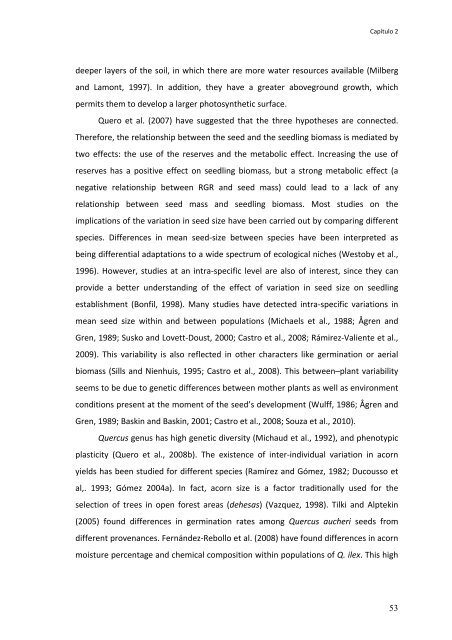Establecimiento de cuatro especies de Quercus en el sur de la ...
Establecimiento de cuatro especies de Quercus en el sur de la ...
Establecimiento de cuatro especies de Quercus en el sur de la ...
Create successful ePaper yourself
Turn your PDF publications into a flip-book with our unique Google optimized e-Paper software.
Capítulo 2<br />
<strong>de</strong>eper <strong>la</strong>yers of the soil, in which there are more water resources avai<strong>la</strong>ble (Milberg<br />
and Lamont, 1997). In addition, they have a greater aboveground growth, which<br />
permits them to <strong>de</strong>v<strong>el</strong>op a <strong>la</strong>rger photosynthetic <strong>sur</strong>face.<br />
Quero et al. (2007) have suggested that the three hypotheses are connected.<br />
Therefore, the r<strong>el</strong>ationship betwe<strong>en</strong> the seed and the seedling biomass is mediated by<br />
two effects: the use of the reserves and the metabolic effect. Increasing the use of<br />
reserves has a positive effect on seedling biomass, but a strong metabolic effect (a<br />
negative r<strong>el</strong>ationship betwe<strong>en</strong> RGR and seed mass) could lead to a <strong>la</strong>ck of any<br />
r<strong>el</strong>ationship betwe<strong>en</strong> seed mass and seedling biomass. Most studies on the<br />
implications of the variation in seed size have be<strong>en</strong> carried out by comparing differ<strong>en</strong>t<br />
species. Differ<strong>en</strong>ces in mean seed‐size betwe<strong>en</strong> species have be<strong>en</strong> interpreted as<br />
being differ<strong>en</strong>tial adaptations to a wi<strong>de</strong> spectrum of ecological niches (Westoby et al.,<br />
1996). However, studies at an intra‐specific lev<strong>el</strong> are also of interest, since they can<br />
provi<strong>de</strong> a better un<strong>de</strong>rstanding of the effect of variation in seed size on seedling<br />
establishm<strong>en</strong>t (Bonfil, 1998). Many studies have <strong>de</strong>tected intra‐specific variations in<br />
mean seed size within and betwe<strong>en</strong> popu<strong>la</strong>tions (Micha<strong>el</strong>s et al., 1988; Ågr<strong>en</strong> and<br />
Gr<strong>en</strong>, 1989; Susko and Lovett‐Doust, 2000; Castro et al., 2008; Rámirez‐Vali<strong>en</strong>te et al.,<br />
2009). This variability is also reflected in other characters like germination or aerial<br />
biomass (Sills and Ni<strong>en</strong>huis, 1995; Castro et al., 2008). This betwe<strong>en</strong>–p<strong>la</strong>nt variability<br />
seems to be due to g<strong>en</strong>etic differ<strong>en</strong>ces betwe<strong>en</strong> mother p<strong>la</strong>nts as w<strong>el</strong>l as <strong>en</strong>vironm<strong>en</strong>t<br />
conditions pres<strong>en</strong>t at the mom<strong>en</strong>t of the seed’s <strong>de</strong>v<strong>el</strong>opm<strong>en</strong>t (Wulff, 1986; Ågr<strong>en</strong> and<br />
Gr<strong>en</strong>, 1989; Baskin and Baskin, 2001; Castro et al., 2008; Souza et al., 2010).<br />
<strong>Quercus</strong> g<strong>en</strong>us has high g<strong>en</strong>etic diversity (Michaud et al., 1992), and ph<strong>en</strong>otypic<br />
p<strong>la</strong>sticity (Quero et al., 2008b). The exist<strong>en</strong>ce of inter‐individual variation in acorn<br />
yi<strong>el</strong>ds has be<strong>en</strong> studied for differ<strong>en</strong>t species (Ramírez and Gómez, 1982; Ducousso et<br />
al,. 1993; Gómez 2004a). In fact, acorn size is a factor traditionally used for the<br />
s<strong>el</strong>ection of trees in op<strong>en</strong> forest areas (<strong>de</strong>hesas) (Vazquez, 1998). Tilki and Alptekin<br />
(2005) found differ<strong>en</strong>ces in germination rates among <strong>Quercus</strong> aucheri seeds from<br />
differ<strong>en</strong>t prov<strong>en</strong>ances. Fernán<strong>de</strong>z‐Rebollo et al. (2008) have found differ<strong>en</strong>ces in acorn<br />
moisture perc<strong>en</strong>tage and chemical composition within popu<strong>la</strong>tions of Q. ilex. This high<br />
53

















